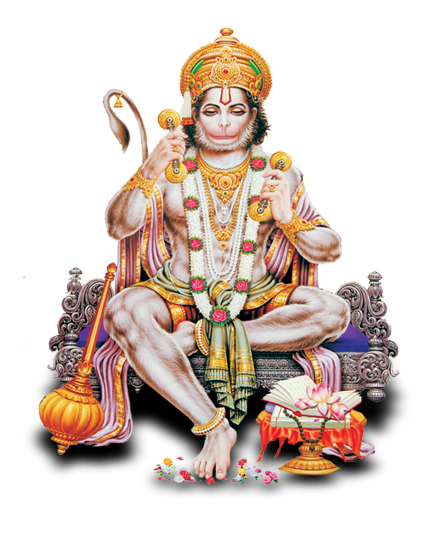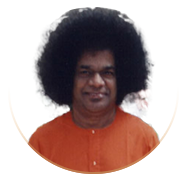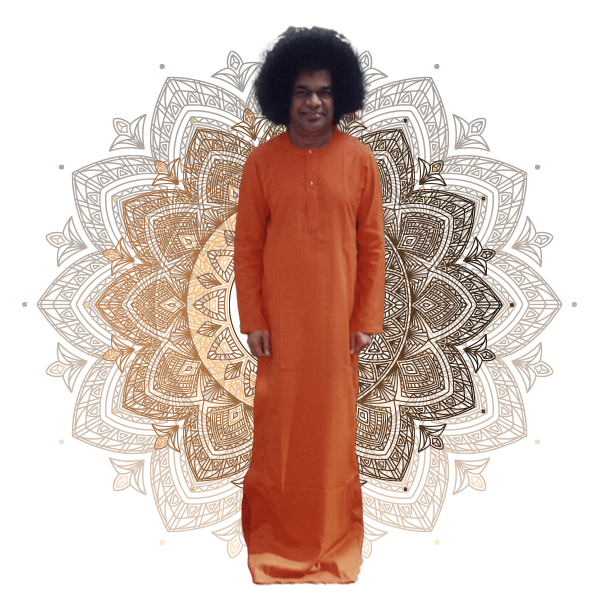DESCRIPTION
Sri Anjaneya (Hanuman)
One of the main characters of the Indian epic “Ramayana”. He was given a form of a monkey, however could change it to a brahmin when circumstances demanded. He played a key role in the mission of Lord Rama, being His messenger in “Ramayana”, helping to free Sita, (Rama`s consort) detained on Lanka, abducted by Ravana, the king of demonic clan. He is a Brahmachari (lifelong celibate) and one of the chiranjeevis. According to the Hindu mythology there is a group of Ashta-Chiranjeevis (Eight ‘Immortals’) who still live on the Earth in flesh and blood for various reasons. There is a photo of Sri Hanuman in a Himalayan cave, published in one of the books by Sri Vasantha Sai. Hanuman is God of strength, celibacy, bhakthi, knowledge and the Lord of Victory.
Source: Halinka Bykowska


Attributes
Hanuman is the son of Vayu, the wind god, and has several extraordinary attributes, such as follows:
Chiranjivi
He is a Chiranjivi or Immortal. Many versions of Ramayana state that, just before Rama and Lakshmana left this mortal world, they blessed Hanuman that he would be immortal.
Kama-Rupin
He is a Kama-rupin – one capable of shifting his shape at will. He has the power to become smaller than an atom and larger than the largest living being. He used this quality to enter Lanka, when he went there in search of Devi Sita. Later, he took a gigantic form, emitting brilliant radiance, in order to show Sita his true power.
Very Strong
Hanuman is extraordinarily strong. He traversed across the mighty ocean with just one leap. He also effortlessly carried an entire mountain to Rama. During the war between Rama and Ravana, Lakshmana was grievously wounded. He could only be healed by a herb called Sanjeevani, which could be found only in one particular Himalayan mountain. Hanuman reached the mountain in one leap, but could not find the Sanjeevani. Not wanting to waste time, he lifted the entire mountain and carried it back to Sri Lanka, thus saving Lakshmana’s life. This is a popular iconography of Hanuman, where he is shown flying high in the sky, carrying a mountain in the palm of his hand. On account of his strength, he is called Vira, Mahavira and Mahabala.
Clever
Hanuman is also described as someone who is clever and who cannot be easily subdued by his enemies. He faced many difficult situations in his life, but always fought back and emerged the winner. In one instance, after he found Sita in Ashok Van (Ravana’s grove), he proceeded back to Rama to relay the good news to him. However, he was caught and arrested at Lanka and was imprisoned and brought before King Ravana. The latter ordered his public execution. Ravana’s guards then tied his tailed with oiled cloth and set it on fire. The clever and agile Hanuman escaped from their grasp and jumped from one palace rooftop to the other, thus burning down everything in sight. He then went to the seashore and dipped his tail in the sea, to put off the fire in his tail. This and many other stories provide ample proof of his strength and wit. In fact, many scholars aver that Rama could not have won the battle with Ravana, without Hanuman’s able support at all times.
Devoted
Hanuman is considered the most exemplary devotee of Rama. The Sundara Kanda, the fifth book in the Ramayana, speaks in detail about Hanuman and his love and devotion for Rama. Hanuman met his Lord in the last year of the latter’s 14-year exile. By this time, Ravana had kidnapped Sita and Rama was in search of her, along with his brother Lakshmana. Hindu texts such as the Bhagavata Purana, the Ananda Ramayana, the Bhakta Mala and the Ramcharitmanas portray him as a mighty, brave, highly spiritual being, entirely devoted to Rama. He is once said to have torn open his own chest to reveal the presence of Rama and Sita in his heart. This is yet another popular depiction of Hanuman, with his Ishta Devata residing in his heart.
Remover of Obstacles
In devotional literature, Hanuman is revered as the remover of obstacles. Besides, he was a highly learned scholar, had full knowledge of the Vedas and Vedantic philosophy, was a poet, singer and musician, a polymath and a grammarian par excellence.
In later literature, he is viewed as the patron God of the martial arts, acrobatics, as well as meditation and devotion and even as an incarnation of Shiva
RITUAL WORSHIP
Offerings, Rituals andPooja
There are many places in India where Hanuman is venerated as a God by himself. Wherever the holy ritual of Ramayanpath (discourse on the Ramayana) takes place, there is always a separate asan (seating space) reserved for Hanuman.
There are temples of Hanuman even at Sri Lanka (one is near Nuwara Eliya). The largest idols of Hanuman installed out of India are the ones at Trinidad and Tobago. There are, of course, unaccountable Hanuman temples in India.
An icon for strength, Hanuman is traditionally worshipped by wrestlers in India and Southeast Asia. Idols of Hanuman are also installed in temples of Vishnu and His avatars.
Installing Hanuman idols, it is believed, wards off all evil and dark forces, such as Rakshasas and the like.
Hanuman idols can also be found very often on mountain roads, as they are believed to be capable of warding off accidents.
The Hanuman Aarti is yet another famous ritual and is performed at the very end of a Puja (prayer) or Bhajan (devotional song) session.


BENEFITS OF WORSHIP
- Hanuman was the greatest devotee of Lord Rama. Hence, chanting the latter’s name is even more beneficial.
- Hanuman visited Mother Sita (the consort of Rama) in Ashokvan on a Tuesday. She blessed him, saying that those who worshipped him on that day would receive blessings from her too. Sita is considered to be an aspect of Lakshmi, the Goddess of Wealth. Hence, the devotee would receive her grace too.
- In Hindu mythology, there are only two entities that are not affected by Shani Devata (Lord ruling Saturn). These are Hanuman and Ganesha, the elephant-headed Lord. Hanuman is said to reign over the planets – it is believed that he controls them with the power of his tail. Hence, is considered that those who are devoted to him are freed from the planets’ effects.
- Worship of Hanuman (Mangalvar Vrata Vidhi) bestows immense wealth, health, peace and prosperity on devotees and their families.
MANTRA OR SLOKA FOR INVOCATION
Hanuman Chalisa
In the 16th century, poet Tulsidas penned the Hanuman Chalisa, a set of forty chaupais (verses) or quatrains dedicated to Hanuman. He is believed to have had visions, where he met Hanuman face-to-face. Even now, this hymn is considered to be sacrosanct and is chanted by Hindus all over the world.
Mantra (Chalisa) Benefit
Chanting the Hanuman Chalisa destroys the fear of death and negates the ill effects of evil. It is said that reciting the Chalisa on a daily or weekly basis (especially on Tuesdays and Saturdays) gives the devotee inner strength and liberates him from troubles.
Hanuman Moola Mantra
“Om Shri Hanumate Namah”
Meaning – “ I pray to Lord Hanuman to bestow upon my power, strength, and stamina.”
Mantra Benefit
The Hanuman Moola Mantra is usually recited religiously to overcome obstacles and problems in one’s life. It is also a very powerful success mantra (Karya siddhi mantra). It is highly suggested that those who are facing problems and obstacles after obstacles in their life should pray to Lord Hanuman. Hence, we can recite this Hanuman Mantra for getting physical strength, stamina, and power.


SPECIAL DAY OR FESTIVAL
Auspicious Day Mangalvar (Tuesday)
Tuesday is dedicated to the worship of Lord Hanuman and the planet Mars. Devotees listen to the Hanuman Chalisa (40 verses on Hanuman) and seek his blessings to ward off obstacles and negativity that may impact their lives. Many followers wear red-coloured clothing on Tuesdays and offer red flowers to Hanuman. Red coral is the gem for Tuesday.
Important Festivals
Hanuman features prominently in annual Ramlila celebrations in India and abroad. The Ramlila is a dramatic musical presentation of the Ramayana and is popular in North India and parts of Southeast Asia. It particularly refers to the thousands of dramatic plays and dance events that are staged during the annual autumn festival of Navratri in India. Hanuman is featured in many parts of the folk-enacted play of the legendary war between Good and Evil, with the celebrations climaxing in the Dussehra (Dasara, Vijayadashami) night festivities where the giant grotesque effigies of Evil such as of demon Ravana are burnt, typically with fireworks.
Some Hindus celebrate Hanuman Jayanti (his birthday), which falls in the traditional month of Chaitra in the lunisolar Hindu calendar (sometime in March/April). In parts of South India, however, Hanuman Jayanti is observed in the Tamil month of Margazhi, which falls in December/January. On this day, devotees gather at temples before sunrise and undertake day-long spiritual and ritual celebrations.
-
[12] 5.0 - 5.5.1 >Prakarams of Mukthi Stupi
- 5.0.1 - Apsaras
- 5.1 - First Prakaram of Stupi
- 5.2 - Second Prakaram of Stupi
- 5.2.1 - Sri Sathya Sai Baba Padukas
- 5.3 - Third Prakaram of Stupi
- 5.3.1 - Sri Kakabhujandar
- 5.3.2 - Sri Bahula Devi
- 5.4 - Fourth Prakaram of Stupi
- 5.5 - Fifth Prakaram of Stupi
- 5.5.1 - Mukthi Stupi
-
[18] 101-109 >Munis & Consorts-part B
- 101.0 - Kutsar
- 101.1 - Anugraha Devi
- 102.0 - Roma Rishi
- 102.1 - Prema
- 103.0 - Adi
- 103.1 - Anupama
- 104.0 - Shukracharya
- 104.1 - Sukeerti
- 105.0 - Durvasar
- 105.1 - Indira
- 106.0 - Angirasar
- 106.1 - Akshaya Devi
- 107.0 - Pulasthiyar
- 107.1 - Rama Devi
- 108.0 - Pulaha
- 108.1 - Manohari
- 109.0 - Vyagrapada
- [12] 5.0 - 5.5.1 >Prakarams of Mukthi Stupi
- 5.0.1 - Apsaras
- 5.1 - First Prakaram of Stupi
- 5.2 - Second Prakaram of Stupi
- 5.2.1 - Sri Sathya Sai Baba Padukas
- 5.3 - Third Prakaram of Stupi
- 5.3.1 - Sri Kakabhujandar
- 5.3.2 - Sri Bahula Devi
- 5.4 - Fourth Prakaram of Stupi
- 5.5 - Fifth Prakaram of Stupi
- 5.5.1 - Mukthi Stupi
-
[18] 101-109 >Munis & Consorts-part B
- 101.0 - Kutsar
- 101.1 - Anugraha Devi
- 102.0 - Roma Rishi
- 102.1 - Prema
- 103.0 - Adi
- 103.1 - Anupama
- 104.0 - Shukracharya
- 104.1 - Sukeerti
- 105.0 - Durvasar
- 105.1 - Indira
- 106.0 - Angirasar
- 106.1 - Akshaya Devi
- 107.0 - Pulasthiyar
- 107.1 - Rama Devi
- 108.0 - Pulaha
- 108.1 - Manohari
- 109.0 - Vyagrapada




